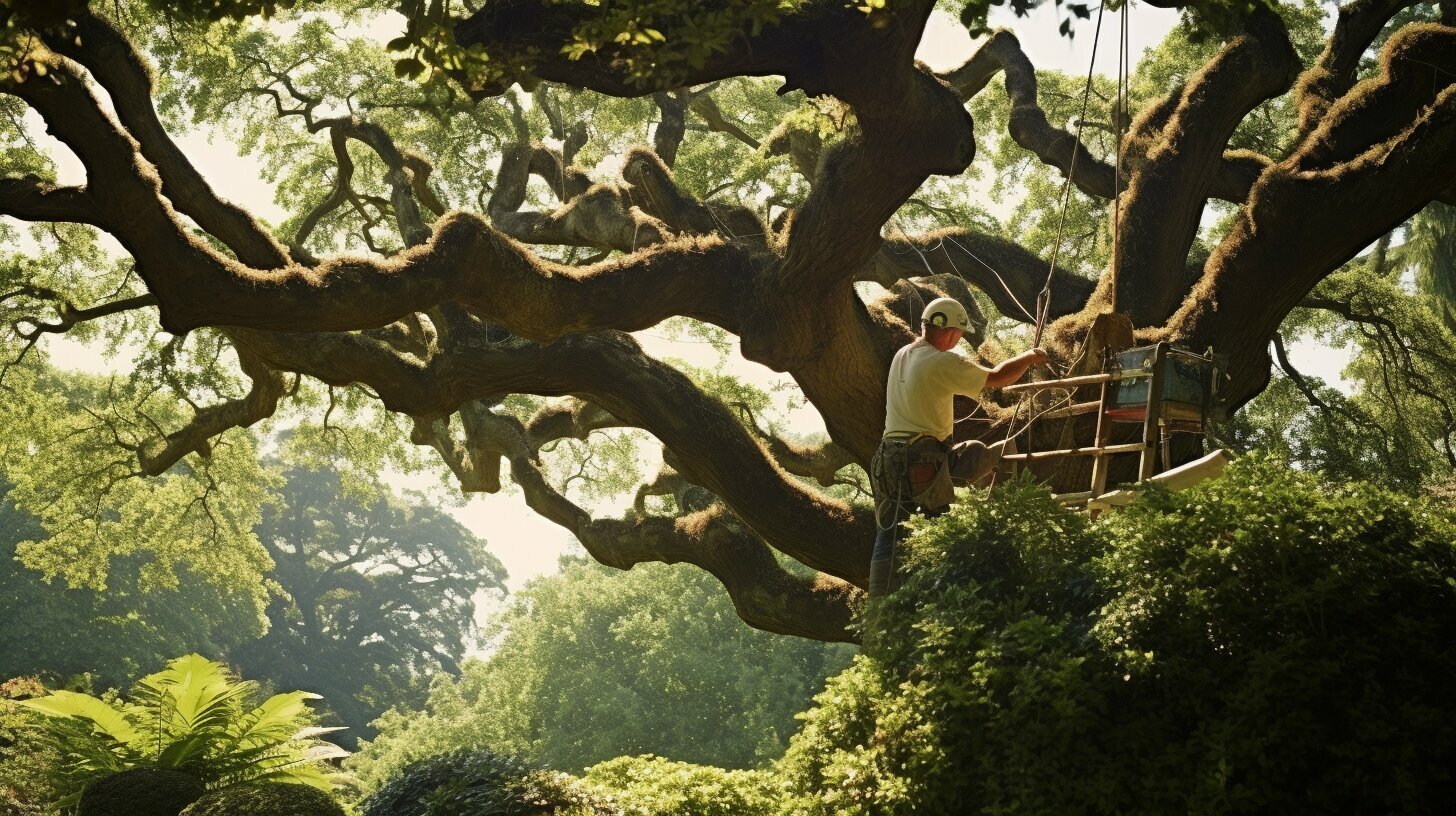Taking care of your oak tree involves regular pruning and maintenance to ensure its health and longevity. Proper care not only enhances the beauty of your tree but also promotes its overall well-being.
Pruning is a crucial aspect of oak tree care, and it should be performed at the right time and in a proper manner. Mid to late winter is the ideal time for pruning, allowing the tree to heal before the spring growth. Young trees require annual pruning to shape them and stimulate healthy growth.
When pruning your oak tree, it’s important to make cuts outside the branch collar to prevent damage to the trunk. Care should be taken to keep the crown of the tree full, ensuring that no more than one-third of the canopy is removed in a single season. This helps maintain the tree’s vitality and structural integrity.
Key Takeaways:
- Pruning oak trees in mid to late winter promotes proper healing and growth.
- Young trees should be pruned annually to shape them and encourage healthy development.
- Make cuts outside the branch collar to avoid damaging the trunk.
- Keep the crown of the tree full, avoiding excessive canopy removal.
- Soak pruning tools in a bleach solution and allow them to air dry before use.
Proper maintenance is equally important in caring for your oak tree. This includes ensuring proper drainage, covering exposed roots with soil, providing sufficient space for growth, and supplying adequate sunlight and water. Regular monitoring for pests and diseases is also essential to catch and address any issues early on.
By following these pruning and maintenance tips, you can ensure the health and longevity of your oak tree, adding beauty and value to your landscape for years to come.
Understanding Oak Tree Pruning
Pruning is an essential aspect of oak tree care, contributing to overall tree health and appearance. Proper pruning techniques help maintain the structural integrity of the tree, promote healthy growth, and prevent the spread of diseases. Understanding the basics of oak tree pruning can greatly benefit your trees and ensure their longevity.
When it comes to pruning oak trees, timing is crucial. It is best to prune during mid to late winter when the tree is dormant. This allows the tree to heal its wounds during the spring, minimizing the risk of infections. Young oak trees should be pruned annually to shape them and encourage strong development. Removing crossing or rubbing branches and maintaining a balanced structure will help the tree grow in a healthy and aesthetically pleasing manner.
When pruning, it is important to make proper cuts to avoid damaging the tree. Always cut outside the branch collar, which is the swollen area where the branch connects to the trunk. This helps the tree heal faster and prevents the spread of decay. Additionally, avoid removing more than one-third of the canopy in a single pruning season to avoid stress on the tree.
Proper Techniques for Oak Tree Pruning
Proper techniques for oak tree pruning involve making clean cuts with sharp tools. Using clean and disinfected pruning tools is crucial to prevent the transmission of diseases between trees. Soak your tools in a bleach solution and allow them to air dry before use. Tools such as pruning shears and saws should be sharp to ensure clean cuts, minimizing damage to the tree. Remember to follow safety precautions and wear protective gear when pruning.
| Pruning Tools | Usage |
|---|---|
| Pruning Shears | Ideal for smaller branches, up to 1 inch in diameter. |
| Pruning Saw | Used for thicker branches, larger than 1 inch in diameter. |
| Pole Pruner | Enables pruning of high branches without the need for a ladder. |
Remember to always follow local regulations and obtain any necessary permits before pruning large oak trees. In some areas, larger trees may require the expertise of a professional arborist.
Pruning mature oak trees differs from pruning young trees. Mature trees should be pruned with specific purposes in mind, such as removing dead or broken branches, improving sunlight penetration into the canopy, and enhancing air circulation. Proper pruning techniques for mature trees involve making clean cuts outside the branch collar, similar to pruning young trees. Removing dead or diseased branches helps prevent the spread of diseases and promotes the overall health of the tree.
Caring for your oak tree involves more than just pruning. Proper drainage, covering exposed roots with soil, providing adequate spacing between trees to allow for proper growth, and ensuring they receive enough sunlight and water are all essential aspects of maintaining healthy oak trees. Regularly monitoring your trees for pests and diseases is also crucial, as these issues can weaken the tree and lead to further complications.
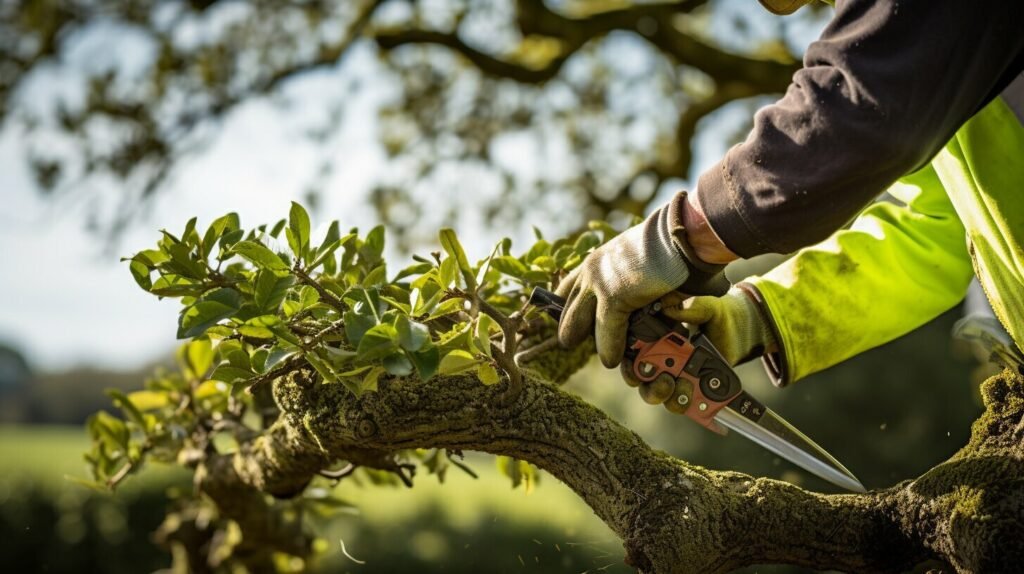
By following proper pruning techniques and caring for your oak trees, you can ensure their health and enhance their beauty. Remember to consult with professionals if you are unsure about any aspect of oak tree care, as their expertise can help keep your trees thriving for years to come.
Proper Techniques for Oak Tree Pruning
When pruning your oak tree, it is crucial to follow proper techniques to promote its health and prevent unnecessary damage. Pruning should be done in mid to late winter when the tree is dormant, allowing it to heal before the spring growth starts. Young trees should be pruned annually to shape them and encourage healthy growth.
One important technique to remember is to make cuts just outside the branch collar, which is the swollen area where the branch meets the trunk. Cutting too close to the trunk can cause damage and hinder healing. Keeping the crown of the tree full is essential, so avoid removing more than one-third of the canopy in a single season.
| Pruning Guidelines for Oak Trees: |
|---|
| • Prune in mid to late winter when the tree is dormant. |
| • Shape young trees through annual pruning. |
| • Make cuts just outside the branch collar to prevent damage. |
| • Avoid removing more than one-third of the canopy in a season. |
| • Soak pruning tools in a bleach solution and air dry to disinfect them. |
Remember, proper pruning techniques are key to maintaining the health and longevity of your oak tree. By following these guidelines, you can ensure that your tree thrives and remains a beautiful addition to your landscape.

Proper care for oak trees goes beyond pruning. It is important to provide adequate drainage and cover exposed roots with soil to protect them from damage. Giving the trees enough space to grow allows for healthy root development and avoids overcrowding. Additionally, ensuring the tree receives sufficient sunlight and water is crucial for its overall health and vitality.
Regular monitoring for pests and diseases is also essential. Common pests such as oak wilt and gypsy moths can cause significant damage to oak trees if left unchecked. Early detection and prevention measures can help protect your tree and maintain its health.
Using the right tools and maintaining their cleanliness is essential when pruning oak trees. Proper equipment ensures clean and precise cuts, promoting tree health and minimizing the risk of disease. To start, you’ll need a pair of sharp bypass pruners for cutting branches up to 1 inch in diameter. These pruners have a curved blade that bypasses the counter blade, resulting in a clean cut that minimizes damage to the tree.
For larger branches, a pruning saw with a narrow, curved blade is ideal. This type of saw allows for controlled and precise cutting, even in tight spaces. Remember to choose a saw with teeth designed for cutting hardwood, as oak trees have tough wood that requires specialized tools.
To disinfect your tools and prevent the spread of diseases, soak them in a bleach solution after each use. Mix 1 part bleach with 9 parts water and let the tools sit in the solution for about 5 minutes. Afterward, rinse them thoroughly with clean water and allow them to air dry. Keeping your tools clean and disinfected is crucial for maintaining tree health.
It’s important to note that using the correct tools is only half the battle. Understanding proper pruning techniques is equally vital for oak tree care. Always make cuts outside the branch collar, which is the swollen area where the branch meets the trunk. Cutting too close to the trunk can cause damage and inhibit the tree’s natural healing process. Additionally, avoid removing more than one-third of the tree’s canopy in a single season to maintain a healthy crown.
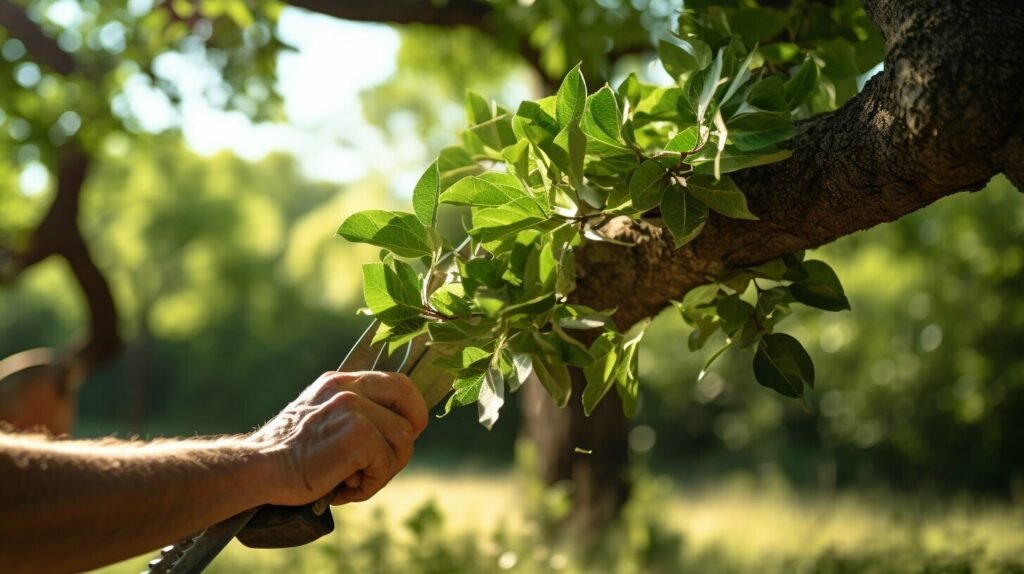
In conclusion, when caring for your oak tree, investing in the right tools and practicing proper maintenance techniques are essential for its health and longevity. By pruning during the appropriate time, using the correct tools, making proper cuts outside the branch collar, and disinfecting your equipment, you can ensure the well-being of your oak tree. Remember to also consider other aspects of tree care, such as providing adequate spacing, sunlight, water, and monitoring for pests and diseases. By following these guidelines, you’ll be able to enjoy the beauty and benefits of a thriving oak tree in your landscape.
| Tools for Oak Tree Pruning |
|---|
| 1. Bypass pruners for branches up to 1 inch in diameter |
| 2. Pruning saw with a narrow, curved blade for larger branches |
Pruning Mature Oak Trees: Maintaining Health and Structural Integrity
Pruning mature oak trees is necessary to maintain their health and structural integrity. As these majestic trees age, they require regular pruning to remove dead or broken branches and improve sunlight and air circulation within their canopies. Proper pruning techniques not only enhance the tree’s appearance but also promote its overall well-being.
When pruning mature oak trees, it is crucial to make proper cuts to prevent damage and ensure the tree’s health. Cuts should be made just outside the branch collar, the swollen area at the base of the branch where it meets the trunk. This technique helps the tree heal more effectively without compromising its integrity. Avoid removing more than one-third of the canopy in a single season to maintain the crown’s fullness and vitality.
Tools used for pruning oak trees should be clean and disinfected to prevent the spread of diseases. Soak your pruning tools, such as shears and saws, in a bleach solution and allow them to air dry before use. This simple step helps safeguard the health of your oak tree and reduces the risk of introducing harmful pathogens.
Proper Pruning Cuts for Oak Trees
When making pruning cuts, it is essential to follow proper techniques to minimize the potential for damage. Start by identifying the branch collar, which is a raised ridge where the branch and trunk meet. Make your cut just beyond the branch collar, avoiding cutting into the trunk or leaving a long stub. This approach allows the tree’s natural healing process to occur, sealing off the wound and reducing the risk of disease or decay.
Additionally, consider the size of the branch being pruned. For larger branches, use a three-cut method to prevent tearing or stripping of bark. Begin by making an undercut several inches from the trunk, followed by a top cut slightly farther out on the branch. Finally, make the final cut just outside the branch collar to remove the remaining stub.
By following these proper pruning techniques, you can effectively maintain the health and structural integrity of your mature oak tree. Regular pruning helps reduce the risk of branch failure, promotes healthy growth, and enhances the overall aesthetic appeal of your landscape.
| Benefits of Pruning Mature Oak Trees | Proper Pruning Techniques |
|---|---|
| 1. Removes dead or broken branches | 1. Identify the branch collar |
| 2. Improves sunlight and air circulation in the canopy | 2. Make cuts just outside the branch collar |
| 3. Enhances tree’s appearance | 3. Avoid removing more than one-third of the canopy in a single season |
| 4. Promotes overall tree health and longevity | 4. Use a three-cut method for larger branches |

Pruning mature oak trees is an essential part of their care and maintenance. By employing proper pruning techniques, you can ensure the tree’s health and structural integrity while enhancing its natural beauty. Remember to make cuts just outside the branch collar, avoid excessive canopy removal, and disinfect your pruning tools. With regular pruning, your oak tree will thrive for years to come.
Other Aspects of Oak Tree Care
In addition to pruning, there are other important factors to consider in the care of your oak tree. Proper tree maintenance plays a crucial role in ensuring its health and longevity. One key aspect is providing adequate drainage around the tree. Excessive water accumulation can lead to root rot and other diseases. To promote proper drainage, avoid planting the tree in low-lying areas or areas prone to flooding. If the soil tends to retain water, consider adding organic matter or creating a drainage system to prevent waterlogging.
Another important consideration is covering exposed roots with soil. Oak trees have shallow root systems that can be easily damaged by foot traffic or lawnmowers. By covering exposed roots with a layer of soil, you protect them from injury and help maintain the tree’s stability. Avoid piling soil directly against the trunk, as it can lead to rot and other complications. Instead, spread a thin layer of soil around the base of the tree, extending it to the outer edge of the canopy.
Proper tree spacing is essential to allow your oak tree to thrive. Giving trees enough space ensures they receive adequate sunlight, water, and nutrients. When planting new trees, consider the mature size of the oak variety and leave enough room for it to grow without overcrowding. This not only promotes healthy growth but also minimizes competition between neighboring trees. Proper spacing allows each tree to develop a strong root system and canopy, resulting in a more visually appealing and structurally sound landscape.
| Tree Maintenance Tips | Description |
|---|---|
| Sunlight | Oak trees thrive in full sun. Ensure they receive at least 6-8 hours of direct sunlight per day. |
| Water | Water your oak tree deeply once a week during dry spells. Provide approximately 1-1.5 inches of water. |
| Pruning | Prune young oak trees annually to shape them and promote healthy growth. For mature trees, prune to remove dead or broken branches and improve sunlight and air circulation in the canopy. |
By considering these aspects of oak tree care, you can ensure the health and vitality of your prized tree. Maintaining proper drainage, covering exposed roots, and allowing sufficient tree spacing contribute to its overall well-being. Additionally, providing adequate sunlight and water, along with regular pruning, promotes optimal growth and enhances the beauty of your oak tree. Remember to monitor for pests and diseases and take action promptly to prevent any potential damage. With proper care, your oak tree will thrive and become a cherished part of your landscape for years to come.
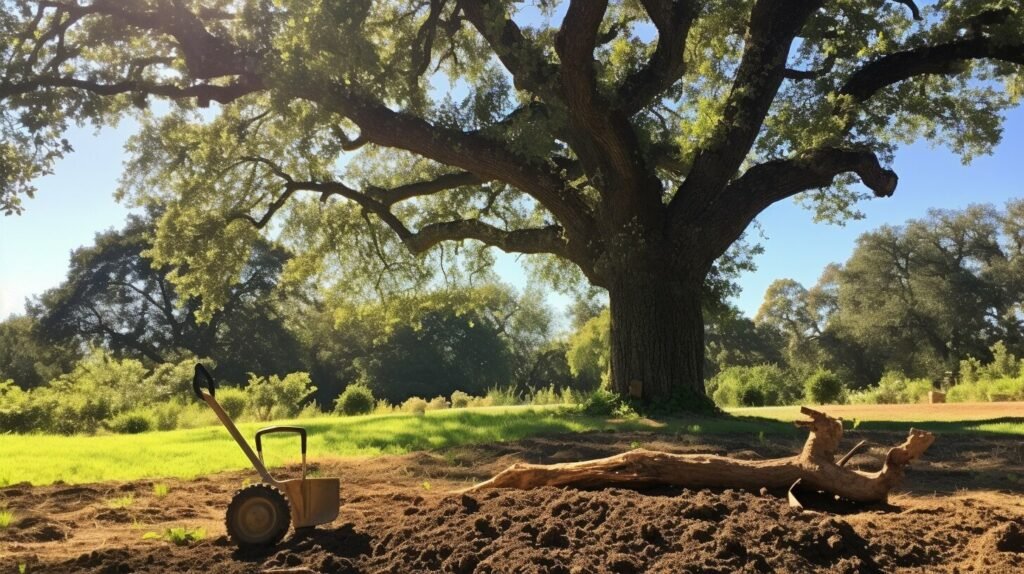
Regular monitoring for pests and diseases is crucial in maintaining the health and vitality of your oak tree. These issues can cause significant damage and weaken the tree if left unchecked. By staying vigilant and taking early action, you can protect your oak tree and ensure its longevity.
When it comes to pests, keep an eye out for common invaders such as oak borers, scale insects, and caterpillars. Symptoms of infestation may include wilting leaves, holes in the bark, or the presence of eggs or larvae. If you notice any signs of pests, it’s important to address the issue promptly. Consult with a professional arborist who can recommend the most effective treatment options.
In addition to pests, oak trees are susceptible to various diseases, including oak wilt and anthracnose. These diseases can cause leaf discoloration, defoliation, and even death if not properly managed. Regularly inspect your oak tree for any unusual symptoms and consult an arborist if you suspect a disease. They can provide guidance on treatment strategies and preventative measures to protect the overall health of your tree.
Remember, prevention is key in oak tree care. Maintain a healthy environment by raking up fallen leaves and debris, as they can harbor pests and pathogens. Avoid excessive watering, as soggy soil can encourage disease development. By keeping a close eye on your oak tree and taking necessary precautions, you can ensure its well-being for years to come.
Common Pests and Diseases of Oak Trees
| Pests | Diseases |
|---|---|
| Oak borers | Oak wilt |
| Scale insects | Anthracnose |
| Caterpillars |
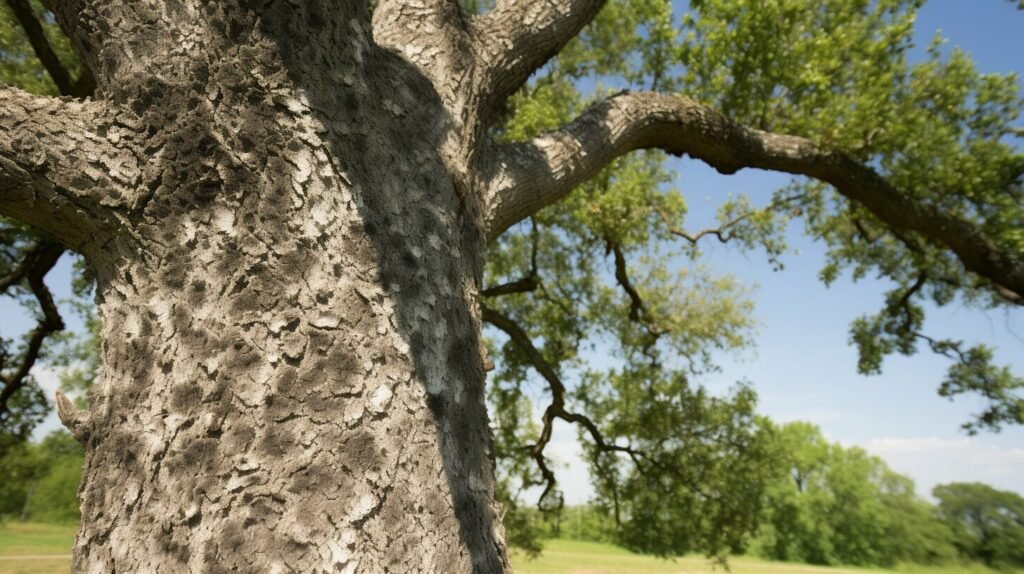
Regular monitoring, prompt action, and proper care are essential for the health of your oak tree. By staying attentive to pests and diseases, you can protect your tree from potential harm and ensure its continued beauty and vitality.
The Benefits of Oak Tree Care
Investing time and effort into caring for your oak tree brings numerous benefits for both the tree and your outdoor space. Proper pruning and maintenance techniques not only ensure the health and longevity of your oak tree but also enhance the overall aesthetic appeal of your surroundings.
When you prune your oak tree at the right time, which is typically in mid to late winter, you allow the tree to heal in the spring, minimizing the risk of diseases. Regular pruning of young trees promotes healthy growth and helps shape them effectively. Remember to make cuts outside the branch collar to protect the trunk from damage.
“Pruning should be done with a purpose, whether it’s to remove dead or broken branches or to improve sunlight and air circulation within the canopy,” advises renowned arborist John Green. By maintaining a full crown and avoiding excessive canopy removal, you ensure that your oak tree remains robust and capable of withstanding environmental stressors.
| Top Benefits of Oak Tree Care |
|---|
| Promotes tree health and longevity |
| Enhances the aesthetic appeal of your outdoor space |
| Improves sunlight and air circulation within the canopy |
| Minimizes the risk of diseases |
| Strengthens the tree’s ability to withstand environmental stressors |
Aside from pruning, caring for your oak tree also encompasses other essential practices. Ensure proper drainage to prevent waterlogging, cover exposed roots with soil to protect them from damage, and allow sufficient spacing between trees to facilitate healthy growth. Additionally, providing adequate sunlight and water is vital for the overall well-being of your oak tree.
Regular monitoring for pests and diseases is crucial to catch any issues early and prevent further damage to your oak tree. Some common pests to look out for include oak wilt, scales, and aphids. By detecting these problems early on, you can implement appropriate measures to safeguard the health of your tree.
Caring for your oak tree may seem like a demanding task, but the benefits it brings far outweigh the efforts involved. With the right techniques and professional assistance when needed, you can enjoy the beauty and resilience of your oak tree for years to come.
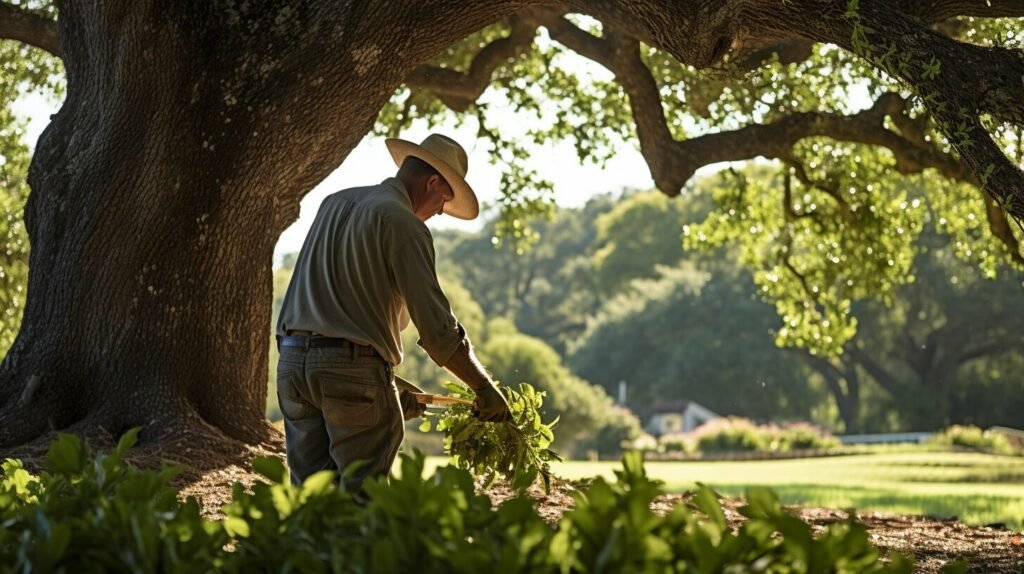
To ensure optimal oak tree health, it’s crucial to be aware of and avoid common care mistakes. Pruning mistakes and maintenance errors can have a significant impact on the well-being of your oak trees. By understanding these pitfalls and taking the necessary precautions, you can help your trees thrive and flourish for years to come.
1. Improper Pruning Techniques
One of the most common mistakes in oak tree care is using incorrect pruning techniques. It’s important to make clean cuts outside the branch collar to prevent damage to the trunk. Avoid leaving stubs or making flush cuts, as these can hinder the tree’s ability to heal properly.
2. Over-Pruning
Removing too much of the tree’s canopy in a single season can be harmful. As a general rule, avoid removing more than one-third of the canopy. Over-pruning can stress the tree and weaken its overall health. It’s best to take a conservative approach and only remove what is necessary for the tree’s well-being.
3. Neglecting Essential Maintenance
Regular maintenance is essential for the health of your oak trees. Neglecting tasks such as proper watering, fertilizing, and mulching can lead to weakened trees and increased susceptibility to pests and diseases. Stay on top of these maintenance practices to ensure your trees receive the care they need.
By avoiding these common oak tree care mistakes, you can promote healthy growth and longevity for your trees. Remember to always follow proper pruning techniques, avoid over-pruning, and stay committed to essential maintenance tasks. With the right care, your oak trees will continue to provide beauty and shade for many years to come.
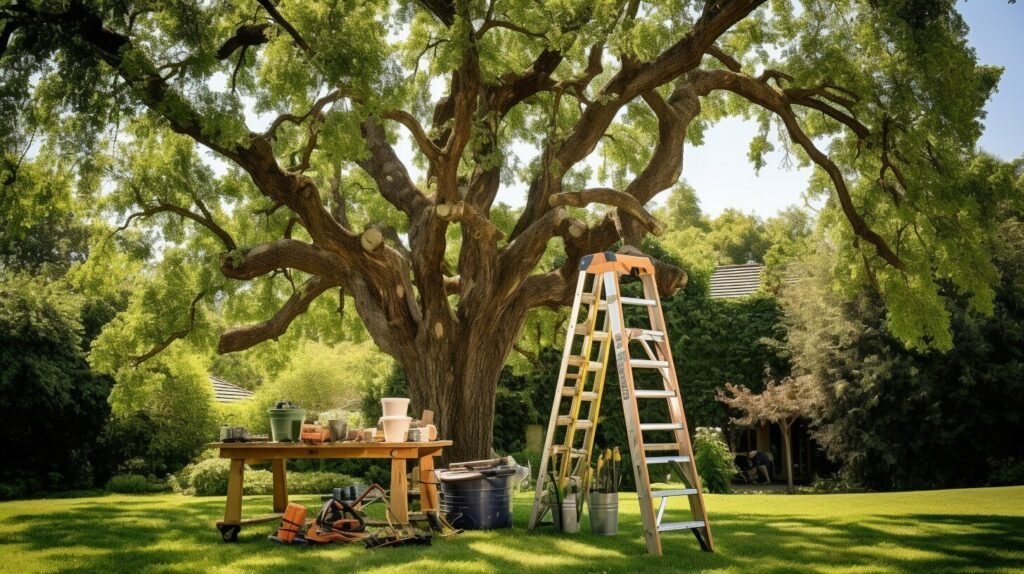
While many aspects of oak tree care can be handled by homeowners, there are times when professional assistance can greatly enhance the health and well-being of your tree. A professional arborist, with their expertise and specialized knowledge, can provide valuable insights and services to ensure your oak tree thrives for years to come.
One of the main benefits of hiring a professional arborist for tree maintenance is their ability to assess the specific needs of your oak tree. They can accurately determine the optimal pruning techniques and timing based on the age, species, and condition of your tree. This ensures that the pruning is done correctly, promoting healthy growth and minimizing the risk of damage to the tree.
Additionally, professional arborists have access to specialized tools and equipment that may not be readily available to homeowners. These tools allow them to perform tasks such as tree trimming, crown thinning, and branch removal with precision and safety. Their expertise in using these tools ensures that the tree is pruned effectively and with minimal impact on its overall health.
| Benefits of Professional Arborist: | Benefits of Professional Arborist: |
|---|---|
| Accurate assessment of tree needs | Access to specialized tools and equipment |
| Effective pruning techniques | Professional expertise and experience |
| Minimizes risk of tree damage | Enhanced tree health and longevity |
Furthermore, professional arborists have a wealth of experience in dealing with various tree-related issues, including diseases, pests, and tree health concerns. They can identify early signs of problems and provide appropriate solutions, preventing further damage and ensuring the well-being of your oak tree.
So, while you may have the ability to perform basic oak tree care tasks, enlisting the help of a professional arborist can truly enhance the overall health and maintenance of your tree. Their expertise, specialized tools, and experience can make a significant difference, ensuring that your oak tree remains a beautiful and thriving addition to your landscape.
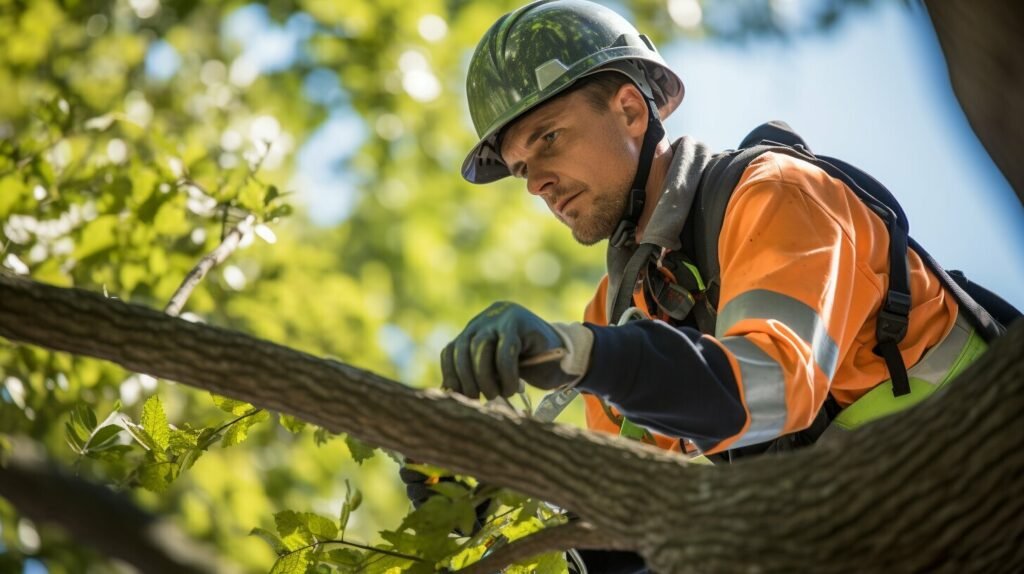
Caring for your oak tree through proper pruning and maintenance is essential to ensure its health, beauty, and longevity. Pruning should be done in mid to late winter, allowing the tree to heal and grow in the spring. Young trees should be pruned annually to shape them and promote healthy growth. When pruning, it is crucial to make cuts outside the branch collar, avoiding damage to the trunk and allowing for optimal healing.
Keeping the crown of the tree full and avoiding excessive canopy removal are key to maintaining a healthy oak tree. It is recommended not to remove more than one-third of the canopy in a single season. To prevent the spread of diseases, tools used for pruning should be soaked in a bleach solution and air-dried before use.
For mature oak trees, pruning serves specific purposes such as removing dead or broken branches and improving sunlight and air circulation within the canopy. Ensuring proper cuts are made during pruning helps prevent damage to the tree. Additionally, caring for oak trees involves proper drainage, covering exposed roots with soil, providing sufficient space for growth, and ensuring adequate sunlight and water.
Regular monitoring for pests and diseases is crucial in maintaining the health of your oak tree. Early detection and prevention can help mitigate damage and ensure the longevity of your tree. By following these essential practices and seeking professional assistance when needed, you can enhance the care and well-being of your oak tree.
FAQ
Q: When is the best time to prune an oak tree?
A: Pruning should be done in mid to late winter to allow the tree to heal in the spring.
Q: How often should young oak trees be pruned?
A: Young trees should be pruned yearly to shape them and promote healthy growth.
Q: How should I make cuts when pruning an oak tree?
A: Make cuts outside the branch collar to avoid damaging the trunk.
Q: How much of the tree’s canopy can be removed in a single pruning season?
A: It is important to avoid removing more than one-third of the canopy in a single season to keep the crown full.
Q: How should I clean my pruning tools?
A: Tools used for pruning should be soaked in a bleach solution and allowed to air dry.
Q: What are the specific purposes for pruning mature oak trees?
A: Pruning mature oak trees should be done to remove dead or broken branches and improve sunlight and air circulation in the canopy.
Q: How can I ensure proper care for my oak tree?
A: Proper care for oak trees includes providing proper drainage, covering exposed roots with soil, giving trees enough space to grow, and providing adequate sunlight and water.
Q: Why is monitoring for pests and diseases important?
A: Monitoring for pests and diseases is essential to prevent damage and weaken the tree.
